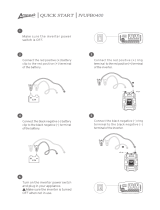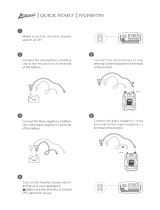
10
3. As the AC product is operated, you can check the level
of the battery as detailed in Section 4.1. This will give
you an idea of how much time remains until the battery
needs recharging.
4. When the battery becomes nearly discharged, or
empty, a low voltage warning will sound. This will give
you time to shut down a computer, for example. If this
warning is ignored, the inverter will switch off
automatically a few minutes later to prevent battery
damage. (See Section 5.3 for full details.)
5. Fully recharge the internal battery as soon as possible
after each use. (See Section 8.)
5.3 Automatic Overload, Overheating, and Low
Battery Protection
Portable Power 250s inverter has built-in protection against
output overload and from overheating. If an AC product rated
higher than 230 watts (or which draws excessive surge power at
start up) is connected, or if the inverter exceeds a safe
temperature, power to the AC outlet will automatically shut off.
If an over temperature condition caused the shut down, the
audio alarm will sound. To reset, unplug the product, turn off
the AC Power ON/OFF Switch, and let the inverter cool.
If an overload condition caused the shut down, unplug the
product and confirm that the product power requirement is 230
watts or less before attempting to restart the product. In the
case of an extreme overload, the 30-amp external fuse located
below the AC outlet will open. It will be necessary to replace
this fuse in order for power to flow to the AC outlet. Replace
only with a 30 A, 32 Vdc, automotive blade type fuse which is
available at many auto parts stores.
If the battery is allowed to discharge excessively, damage may
occur. To prevent this, an audio warning alerts you when the
internal battery is nearly discharged (10.7 volts). If this warning
is ignored, the inverter will automatically switch off when the
battery reaches empty (10.0 volts). Promptly recharge the
battery. (See Section 8.)































